




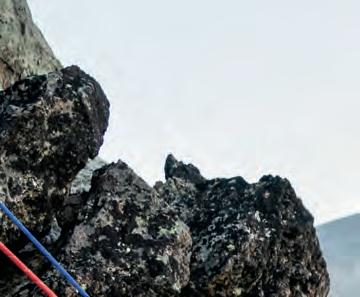
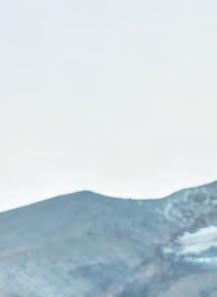





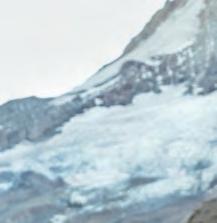
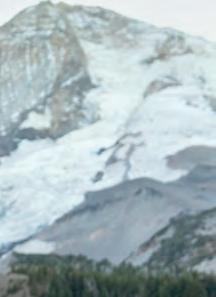
High

















Crag Rats contend with a surge in rescue missions
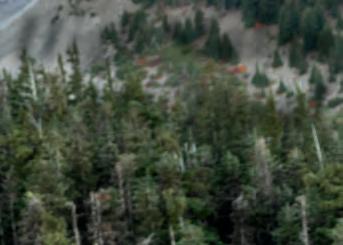

Public lands face fewer caretakers

A verse-lined path through the city



Maui Meyer principal broker or/wa 541-490-3051 maui@copperwest.com

Melissa Alvarado broker, or 541-980-8977 melissa@copperwest.com

Vicki Brennan broker or 541-399-3678 vicki@copperwest.com
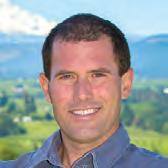
Hunter Lowery broker or/wa 541-490-5917 hunter@copperwest.com

Rita Ketler managing principal broker 541-400-0449 rita@copperwest.com

Sean Aiken principal broker, or/wa 541-490-8277 seanaiken@copperwest.com

Phineas England broker or/wa 541-490-9666 phineas@copperwest.com

Judy Dutcher broker or/wa 541-490-6327 judy@copperwest.com

Elizabeth Turner gen mgr/broker or/wa 541-490-6552 elizabeth@copperwest.com

Paul Thompson principal broker, or/wa 541-490-1044 paul@copperwest.com

Anne McAllister broker or 541-705-7890 anne@copperwest.com

Cyndee Kurahara

Dennis Morgan principal broker or/wa 541-980-3669 dennis@copperwest.com

Candice Richards principal broker or/wa 541-912-5999 candice@copperwest.com

Anne Medenbach
broker or/wa 541-645-0646 annem@copperwest.com

or/wa 541-490-1396 cyndee@copperwest.com Ross
ross@copperwest.com

or/wa 541-490-4433 julie@copperwest.com

Sonya Rubio broker, or/wa 509-637-6445 sonya@copperwest.com

Heather Bremer broker or/wa 541-980-5182 heather@copperwest.com


Bill Irving principal broker or/wa 503-816-9251 bill@copperwest.com
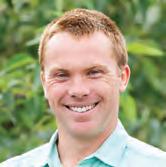
Cody Cornett broker, or/wa 219-916-0451 cody@copperwest.com

Erin V Pollard broker or/wa 541-705-7798 erin@copperwest.com


















































NOT LONG after I moved to Portland in the 1980s for college, one of the biggest stories of the decade happened. In May 1986, a group of students from Oregon Episcopal School — located a few miles from my dorm at Lewis & Clark College — got stranded in a storm while attempting to climb Mount Hood. My roommate had a small black-and-white TV and in those pre-internet days, we were glued to news coverage of the search.
Because of the storm, it took three days for search-and-rescue crews to locate a snow cave the stranded climbers had built. Ultimately, seven students and two staff members died in the tragedy. All told, searchers from alpine rescue groups all over Oregon and Washington logged nearly 6,000 hours on the mountain as the search unfolded. The Hood River Crag Rats was one of them.
Christopher Van Tilburg, a 25-year veteran of the Crag Rats, wasn’t part of the group at the time, but he’s since been on hundreds of search-and-rescue missions on Mount Hood and in the Columbia Gorge. He’s written a book about the Crag Rats, the nation’s oldest mountain rescue team, and the increasingly untenable situation on Mount Hood. In the years since the 1986 tragedy, there’s been a dramatic rise in the number of climbers on the mountain, and increasing risks as the climbing season gets pushed beyond its safest window. Physical changes brought about in part by climate change are also contributing to more dangerous conditions. Rescue season for the Crag Rats used to be spring and summer. Now, according to Van Tilburg, it’s nearly year-round. He wrote our cover story about Mount Hood, the Crag Rats and what’s happening on the mountain, starting on page 42.
If you’re a user of the Indian Creek Trail in Hood River, you may have noticed a new addition to the trail of late: poems. That’s right, metal signs inscribed with poems have been installed on two sections of the trail. The Indian Creek Poetry Walk is the work of Hood River resident Paul Woolery, who calls it a “gift for the community.” Indeed it is. You can read about it starting on page 50. And thank you, Paul.
Don’t miss our story by David Hanson about how Trump administration cuts to federal agencies and programs could affect public lands in and around the Gorge (page 36). Reductions to staff and resources may impact recreation areas during the busy summer season, and are likely to have longer-term consequences.
We hope you enjoy these stories and others in this issue, along with the beautiful images and also the ads by our loyal advertisers. They make this free magazine possible, and we encourage you to support them. Thanks for reading, and have a great summer!
— Janet Cook, Editor













White Salmon-based photographer COREY ARNOLD took our cover image of Christopher Van Tilburg at Cloud Cap Saddle while training with the Hood River Crag Rats. The mountain rescue team — the nation’s oldest — does 30 to 40 training sessions per year on Mount Hood and in the Columbia River Gorge. It’s practice for the 50 or more days the team spends on search and rescue missions every year. coreyfishes.com
When you have read this issue please pass it on to a friend or recycle it. Together we can make a difference in preserving and conserving our resources.


EDITOR
Janet Cook
CREATIVE DIRECTOR & GRAPHIC DESIGNER
Renata Kosina
ADVERTISING DIRECTOR
Jody Thompson
ADVERTISING SALES
Kim Horton, Christine Olivera
CONTRIBUTING WRITERS
Molly Allen, Ruth Berkowitz, David Hanson, Kacie McMackin, Jana Shepherd, Christopher Van Tilburg
COVER PHOTOGRAPHER
Corey Arnold
CONTRIBUTING PHOTOGRAPHERS
Molly Allen, David Hanson, Kacie McMackin, Jana Shepherd, Kelly Turso, Christopher Van Tilburg
TO ADVERTISE IN THE GORGE MAGAZINE please contact Jody Thompson jthompson@thegorgemagazine.com
VISIT US ON SOCIAL MEDIA @thegorgemagazine on Instagram
THE GORGE MAGAZINE 1812 Belmont Ave. Hood River, OR 97031
We appreciate your feedback. Please email comments to: jcook@thegorgemagazine.com



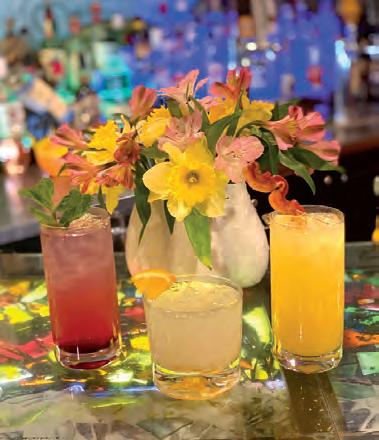


The house-roasted tri-tip sandwich is a popular menu item at the




story & photos by JANA SHEPHERD
IN THE CREATIVE HEART OF THE COLUMBIA RIVER GORGE, tucked among rolling hills and towering evergreens, the hum of saws and the scent of fresh-cut wood drift from the Gorge MakerSpace in White Salmon. It’s here that Lacey Spray — woodworker, artist and teacher — has found not only her craft but also her community.
Spray’s path to becoming a beloved figure at the MakerSpace wasn’t part of a grand plan. In fact, it all began with a single class. “I took a woodturning class out of curiosity,” she says. “That’s when my woodworking really started to get exciting. I could make perfect circles. I could add legs to things.” That class sparked a deeper engagement — more courses, regular open shop hours, and eventually, a transition from student to instructor. Spray is quick to credit her mentor, Marjin Wall, with her genuine love of learning, and continues to seek guidance from Wall’s years of volunteer work at Gorge MakerSpace.
Today, Spray leads youth and adult programming at the collaborative workspace in White Salmon, which offers shared tools and expertise through classes and open shop hours. She serves as a vibrant example of how creative curiosity can evolve into community leadership.
Originally from Albany, Oregon, Spray and her family moved to the Gorge in 2014, but her journey in woodworking began long before. Her first project was a collapsible bed for college, made from a tree that fell on her dad’s property. “It was too hard to find exactly what I wanted,” she recalls of shopping for a bed. “I remember thinking how cool it was to be making my own bed. It was rustic, to say the least, but I slept in it for a year.” That first project planted a seed that has continued to grow.
These days, Spray’s work is anything but rustic. She creates functional art from sustainably sourced, salvaged hardwoods, carefully selected from around the Gorge and the Willamette Valley. Each piece is guided by the natural attributes of the wood — its knots, cracks, grain and even its moss. “I let the material lead,” she says. “Sometimes I go to the shop to clean up, but then I see a knot or a curve, and I have to follow it. Suddenly, I’m deep into a new project.” Her intuitive style embraces spontaneity and imperfection — often using melted-down bullet casings for details like handles, feet or decorative stitches.



Names matter to Spray. Each piece is a story rooted in place: “Pine Grove Pear,” “Library Oak,” “Dan’s Black Walnut.” She mills her own wood, getting to know its characteristics long before it becomes a nished object. “ e process is healthy, it’s sustainable, and it connects me to the land,” she explains. at commitment to connection extends beyond the work itself — it’s at the core of how she teaches, creates and lives.
When asked to name her most challenging project, Spray doesn’t hesitate: the family dining table. It was her rst major piece and her personal celebration after selling a business she’d run for ten years. She worked outdoors, sometimes under a popup tent, nishing the top with a foam roller and a nish sander. “I had no idea what I was doing, but I was determined,” she laughs.
Another memorable creation was a wind mobile she crafted in the lead-up to her rst Gorge Artists Open Studios Tour. It took 28 hours and included input from a neighborhood silversmith, Jerry Titus, who inspired her to melt bullet casings for hardware. “ at mobile represents the magic of this community,” she says. “People slow down. ey take interest. ey help. It really feels good.”





at spirit of collaboration and shared learning is central to Gorge MakerSpace, which has evolved from its roots as a community studio and workspace to being a hub of inspiration. “I went there originally for access to bigger equipment,” Spray says. “But what I found was a group of generous, talented people. Every time I show up for Open Shop, I learn something new.”
And she’s giving that knowledge back in spades. Whether she’s guiding youth through their rst project or mentoring adults on




sharpening technique, Spray sees woodworking as more than craftsmanship. “It builds con dence, problem-solving skills, perseverance, even emotional awareness,” she says. “And it brings people into the present moment. It’s therapy.”




Her teaching philosophy centers on accessibility and exploration. “The MakerSpace makes it possible,” she says. “We try to make it affordable for anyone to come in, use the tools and just start making. It’s about learning by doing. I used to try to explain everything first, but now I focus on helping students collect problems and solve them together. That’s when real learning happens.”
Spray’s impact on the local creative community has extended far beyond the MakerSpace. She’s shown her work at Sustain Home, participated in numerous artisan markets around the Gorge, and joined artist networks to deepen her practice. But teaching remains her anchor. “It takes the pressure off having to sell every piece,” she says. “And it’s a way to give back. When I was starting my first business, mentors volunteered hours of their time to help me. Teaching, no matter what it is, is how I return the favor.”
As for the future? Spray is excited about upcoming welding classes at the MakerSpace, as well as a new community project that combines reclaimed materials, skill building and creative exploration. “It’s a win-win-win-win,” she grins.
Lacey Spray is more than a talented woodworker — she’s a creative force, a generous teacher and a reminder that the most inspiring journeys can start with a single class and an open mind.
To learn more, go to gorgemakerspace.org
Jana Shepherd is a writer living in Lyle. She’s a frequent contributor to The Gorge Magazine


3BD/2BA | 40 ACRES | 3,900 SQ FT 505 KNIGHT ROAD, GOLDENDALE, WASHINGTON


WITH PANORAMIC MT. HOOD VIEWS highlighted through every south-facing window, this custom estate designed by two AIA award-winning architects celebrates architectural ingenuity and the stunning landscape that surrounds it. Redefining indoor-outdoor living, the heart of the home is a 1,200 sq ft stylish “garage mahal” with East and West facing 14’ commercial doors for oversized vehicles and projects, as well as a third garage door expanding the main living area into a versatile and inspiring modern retreat. Welcome to your gateway to the Pacific Northwest.


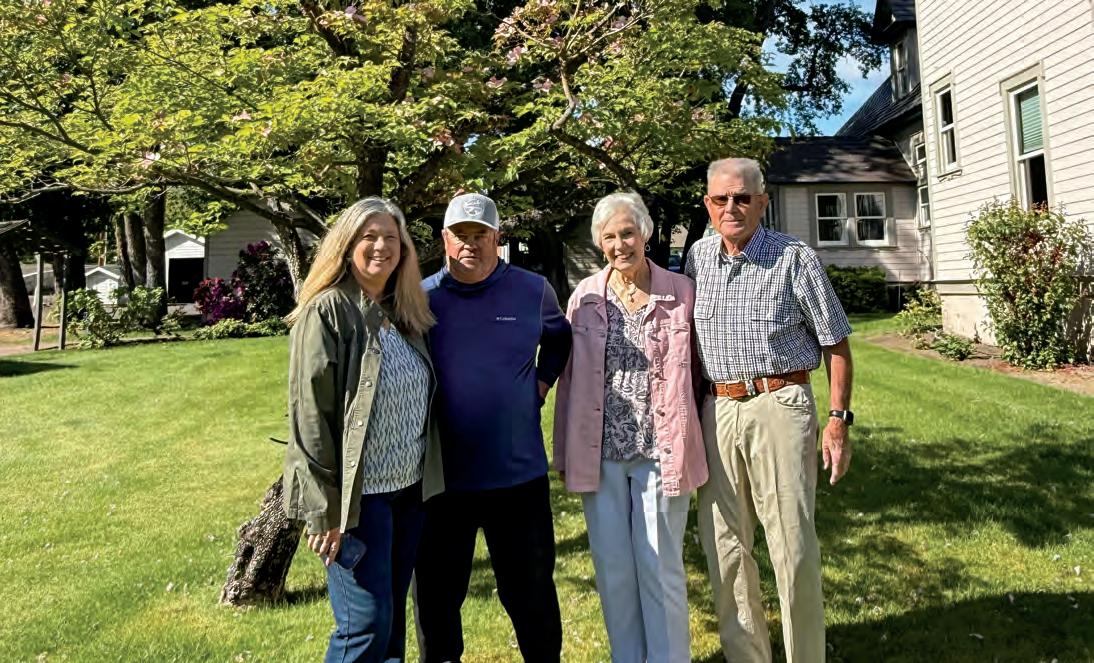
story by MOLLY ALLEN • photos by MOLLY ALLEN & JANET COOK


ACROSS THE NORTHWEST, MORE 60,000 acres of cherry trees grow, producing a favorite summertime fruit that appears in grocery stores and farmers markets in late June.
ose many acres are tended to by passionate farmers across Oregon, Washington and Idaho. One of these operations is Cooper Orchards in e Dalles, which has been growing cherries for more than 130 years, spanning ve generations.
Stacey Cooper’s great-great-grandfather established the Cooper homestead in 1869, initially raising draft horses on the farm. Plums, peaches, watermelon, cherries and hay were all grown on the dry-land farm as well. “It was a fruit operation,” said Cooper. “ ey would take the fruit down to the train station to go to market.”
In 1910, the farm’s rst pro t was made from selling cherries. Cooper estimates the rst trees must have been planted in the early 1900s in order to produce a crop substantial enough to turn a pro t by then. at was the start of what has become a generations-old cherry orchard, consistently delivering quality fruit to both domestic and international markets.
“ ings have moved fairly progressively since the 1950s,” Cooper said. “ e irrigation district went in in 1965, and the area transitioned from dry-land farming to irrigated cherries.”
Cooper grew up in the orchard, watching her dad manage the operation. She moved away to go to Northern Arizona University and continued living in Arizona after college. In 1999, she decided to return. “I missed home,” she said. “I became more involved, and learned from my dad and other growers.”


ough her parents, David and Karen Cooper, are still very much involved, Stacey Cooper is now at the helm, managing about 300 acres of cherry orchards.
Before spring arrives, the trees are dormant, so pruning is done to invigorate them for new growth. e climate in e Dalles is also ideal for cherry trees at this time. It o ers what Cooper refers to as “good dormant chill.” e rain shadow in the area also plays a crucial role, as cherries don’t like the rain. Once spring arrives, it’s the beginning of a short timeline before harvest. When the trees begin to bloom, it’s about 90 days before cherries will be ready for picking.
In spring, the orchards are fertilized and watered, along with receiving a nutrient spray. Depending on the variety, the cherry tree bloom can last up to three weeks. “A good bloom is about a week for viability,” said Cooper. During bloom time, bees are brought into the orchards to help with pollination, and the cherries start to develop their pits in early May.
“In mid-May, we can start guring out harvest by degree days, and we start putting out the call for crews,” she said, noting that Cooper Orchards houses 95 percent of their workers on-site. Everything — and everyone — gets prepped for a fast and furious harvest.
At around June 18, cherries are ripe and ready for picking — a specialized skill that requires both precision and e ciency.
While Rainier cherries are picked based on brix, or the fruit’s sugar level, other varieties are picked depending on color and consistency throughout the tree. ere’s a two- to three-day window from when the cherries are determined to be ready for harvest and when they need to be picked o the trees, as heat and time become the enemy.
Every piece of fruit is picked by hand, either on foot or ladder. “When my parents got married, they were still picking into 50pound fruit lugs, but that changed to bucket picking,” said Cooper — a transition that was transformational. e change allowed pickers to maintain their own identity or card, and to be paid by how much fruit was picked.











Today, cherries are picked into a 25-pound bucket, and a ticket is scanned into a handheld device every time a bucket is dumped into a bin. e bins are two-stack, half the size of an apple bin, and hold about 20 buckets worth of fruit. Each person picking is paid by the buckets they ll, with most making $20 to $45 per hour.





Once the fruit is picked, the travel time from the orchard to an area grocery store is impressively quick. Fruit is immediately taken to hydrocoolers to chill it down. From there, the cherries are sized and packed within two days and short-shipped within a week for nearby markets.
At the packing house, every single cherry goes down an optical line, which quickly takes dozens of photos. is procedure assesses the size, rmness, color and overall quality, ensuring that each cherry that is packed and shipped to grocery stores is up to standard. is technology, a big change from slower packing lines done by hand, has resulted in less waste. Fruit is either packed and shipped fresh for grocery store produce displays, or it heads to brine and is used for other food items, ultimately limiting the amount that ends up as waste.
Fresh cherries are only on the market for eight to 12 weeks, but we enjoy a longer window in the Paci c Northwest. At Cooper Orchards, the fruit trees are tended to with care, picked with precision, and harvested e ciently to ensure the best quality fruit is making its way to consumers.
“For all of us in farming, and especially a specialty crop, it’s a passion and a lifestyle,” said Cooper. “It’s not easy but it’s something we love to do, and we appreciate everyone involved.”



























































































































































STEFANIE BERGH SETS UP HER TRIPOD and attaches a spotting scope for use in search of the breeding Greater Sandhill Crane. is majestic long-legged bird, Grus canadensis tabida, with its distinctive red crown is one of the largest and oldest species in the United States. Standing over three and a half feet tall, the Greater Sandhill Crane, along with the Lesser and the Canadian subspecies, is listed as endangered in Washington State, so nding a nest at the Conboy Lake National Wildlife Refuge in Glenwood is reason to celebrate.
On a chilly, windy day in late April, I joined Bergh, a biologist for the Washington Department of Fish and Wildlife (WDFW) and a group of biologists and volunteers at the


refuge headquarters located at the foot of Mount Adams. We set out in our vehicles to survey particular areas. Last year, they found eight breeding pairs in the refuge. ere are about 40 known breeding pairs in Klickitat and Yakima counties. Biologists recently found nests as far away as the Methow Valley and Ridge eld, Washington, indicating an expansion of territory and a positive sign that the cranes are faring better.


Greater Sandhill Cranes can live 20 to 30 years, mating for life. Migrating from California’s Central Valley, the cranes build their nests in the spring. e pairs gather sticks, grass and mud in open wet meadows and marshy areas surrounded by water, which helps deter predators like coyotes and bears. After the female lays one to two eggs, the pair takes turns incubating the brown and white speckled eggs, never leaving their nests unsupervised.
“Look in the wet grassy area for a head,” Bergh advises as we scan the horizon. “If it’s not moving, then it might be nesting on an egg. en look around for another crane nearby.” e nests are large, but hard to spot — low and hidden in the tall grass. We hear their distinct bugling call in the distance but see no birds, so we continue on the road. Sounding prehistoric and similar to a creaking door, the crane’s calls gurgle. e noise resonates through their windpipe, which coils down their long necks.
“ ere’s one,” Bergh says suddenly, and we veer to the side of the road. Looking through binoculars, I can see the grey plumage in the distance. Its head bobs up and down as the bird forages for food. ey eat insects, snails, amphibians, berries, grains and seeds. Glued to our binoculars and scopes, we remain, hoping to see another crane that might lead us to the nest. Bergh has been monitoring cranes for WDFW















nearly every year since 2015. Although we didn’t nd a treasure this evening, she has found nests, including one instance where she kayaked in a local wetland and used a photograph, with embedded GPS coordinates, to con rm an empty nest. at time, she found eggshell fragments.
At the turn of the twentieth century, hundreds of cranes and other birds nested in and around the marshy wetland area of the Conboy/Camas Lake Beds, now known as Conboy Lake National Wildlife Refuge. But homesteaders, including Peter Conboy, for whom the lake is named, began arriving in the mid-to-late



1800s, and they wanted to transform the land from marshy wetlands into a drier area more suitable for growing hay and raising cattle. e settlers drained the lake and built canals to divert water. ey also hunted the cranes, calling them “the ribeye of the sky.” e e ect was disastrous. e cranes were “extirpated” — rooted out and destroyed completely — along with other species,









including the endangered Oregon Spotted Frog. Fortunately, the cranes are slowly returning here to nest thanks in part to the 6,500acre Conboy Lake National Wildlife Refuge, created in 1964. Run by the U.S. Fish and Wildlife Service, the refuge staff diligently works to improve the wetlands by controlling water levels and reducing the impacts of humans and invasive animals like cattle and bullfrogs. The area is now the largest breeding area of Greater Sandhill Cranes in the state of Washington. Sandhill cranes also breed in Oregon’s Malheur National Wildlife Refuge, which has documented more than 200 breeding pairs.
Bergh said that although the department doesn’t have precise numbers of nesting cranes, she knows that many have returned to the area to breed, and some are spreading their territory north. According to the WDFW archives, in 1941 only one recorded crane nest was found in the state, near Signal Peak on the Yakama Indian Reservation. Harold Cole, who served as Conboy Lake National Wildlife Refuge manager, found one nest in 1979, almost 40 years later. Thinking back on that moment now, he understands its importance. “Although I didn’t know it at the time, it was one of the highlights of my career,” Cole says. Finding that nest sparked efforts to prioritize the cranes.
Since then, nesting has slowly increased. In 1988, scientists found from two to six nesting pairs, and then nine more in 1996. In 2016, biologist David Anderson, Bergh’s former boss, surveyed the area using helicopters and a fixed wing plane. He located 37




pairs. Being able to spot nests from the sky made the search easier, albeit more expensive.
This year, Bergh doesn’t have the aid of helicopters to monitor the cranes, so in addition to the ground surveys, she used drones to survey all areas except the Conboy refuge, which prohibits drones due to federal policies. In the other areas, Bergh flew her drone above 215 feet to avoid disturbing the cranes.




























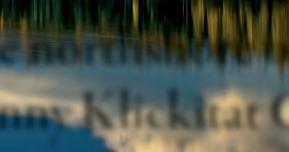


Guided tours for individuals, groups, families, or couples. Including waterfalls, wild owers, wineries, breweries, trail hikes, scenic drives and more. Sit back and relax as we explore the hidden treasures of the Columbia River Gorge National Scenic Area.
503-349-1323 • martinsgorgetours.com
OUTDOOR SPACES BUILT TO LAST
From custom decks and fences to full exterior remodels, we create beautiful, functional outdoor living spaces with quality cra smanship and attention to detail.
541-288-8384 sterlingconstructionllc.com
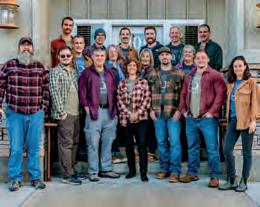
Meeting your Civil Engineering & Land Surveying needs since 1994. Water & sewer system design, site plans & structural support, subdivisions & short plats; We help you make your idea work!
509-493-3886 • belldesigncompany.com 900 W Steuben • Bingen

Welcome to the perfect base for exploring the Columbia River Gorge. River view guest rooms, dining and drinks at Riverside, heated shoreline pool, spas, sauna, shoreline path, seasonal packages.
800-828-7873 • hoodriverinn.com
1108 E. Marina Way • Hood River

We have something for everyone at your local family-owned hobby and game store. Games, toys, discs, kites, RC vehicles, models, cra s, events, and more! Come nd a new hobby or a unique gi .
541-386-1223 • hoodriverhobbies.com 110 - 4th St. • Downtown Hood River

Wines that tell the story of the places they're grown. Sub-alpine climate, volcanic soil, regenerative organic farming, wild yeast fermentation, minimal intervention and thoughtful intentions.
503-298-9420 • loopdeloopvintner.com 451 Kramer Rd. • Underwood

e Cangiamilla family winery provides hand cra ed wines from vineyards of the Columbia River Gorge. Located in the center of the Lyle wine region, our new tasting room is open April through October. viacangiamillavineyards.com 19 Sauter Rd. • Lyle • 509-310-7986

WinePressNorthwest’s “2015 Paci c Northwest Winery of the Year”, 50+ award-winning wines, tasting room, Tuscan-style terrace with views of Mt. Hood and Columbia River, Bocce, and gi s.
877-627-9445
maryhillwinery.com
9774 Hwy 14 Goldendale






















































































































































When the cranes arrive from California in early March, they engage in various territorial and courtship dances. Robyn Reeder King, a biological technician at the Conboy refuge, told me that one year the cranes returned a little too early and had to endure a late-season snowstorm. “When I see them returning, I am usually in the eld looking for Oregon Spotted Frog egg masses and it feels like a friend is coming home,” she says. “ ey are an indicator for spring.”
King, who was on a di erent team during the April ground survey, witnessed a crane returning to the nest. “ e crane ew low and then walked a bit,” she says. “ en another crane came toward it. ey came together and it seemed like they hugged each other before their exchange.” Bergh spent the night at the refuge and early the next morning saw a crane doing a dance while carrying a duck egg — a courtship ritual she’d never witnessed before. Typical courtship includes bowing, running, wing apping and tossing sticks.
A few days after the April survey, King con rmed 12 breeding pairs at the refuge. She will continue to monitor the pairs and is especially excited to see the colts — the term for sandhill crane chicks — which will hatch after 30 days. e colts stay close to their parents throughout the summer, but even so, many don’t make it to adulthood. e refuge will have a better sense of their survival when King conducts another survey in the fall, just before the birds migrate back to California. is summer, you can visit Conboy Lake National Wildlife Refuge and, if lucky, you might see a pair of cranes with their young. Although a large portion of the refuge is unavailable to the public, you can walk its three-mile nature trail. If interested, consider volunteering with the refuge or the WDFW to help with their wildlife surveys.
Ruth Berkowitz, a mediator and writer living in Hood River, is a
Gorge Magazine.



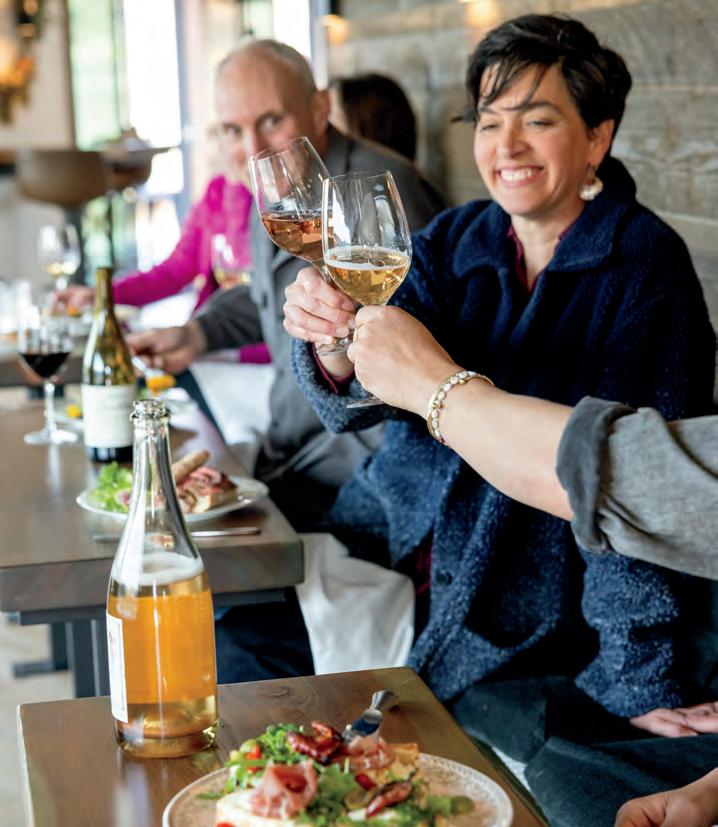
A PLACE TO SAVOR SIPS, BITES AND THE SCENERY
ALEXIS AND JULIET POUILLON HAVE COME DOWN FROM THE HILLS.
eir bucolic winery and tasting room, Domaine Pouillon, located four miles above Lyle, is still there, welcoming visitors on the rst weekend of every month. But now you can nd this wine-making duo — along with their Rhône-style wines and food pairings — in a more convenient location at the con uence of the Klickitat and Columbia rivers in Lyle.
e Domaine Pouillon Wine Bistro, along with the Con uence Café, owned and operated by Ali Hamerstadt and Matt Bynum, each occupy half of the building at the west end of Lyle. e interior space ows seamlessly between the wine bistro and the co ee café, so that guests sipping espresso might be sitting within conversation-distance of those sipping Provençe-style rosé. Somehow, it works beautifully.
e blending of the spaces was an intentional design on the part of the building’s owners, John Streur and Mary Kleihege, who also own and operate the Little Seven Seven Ranch
outside of Lyle, where they raise Highland cattle. When they bought the Lyle building four years ago, the main level was divided into nine individual rooms — most used as o ces — with a small deck on the south side. After the Pouillons, and Hamerstadt and Bynum, signed on to occupy the building, Streur and Kleihege set out to create a space worthy of the location and its occupants.
“It’s such a beautiful view, we didn’t want it to be divided into two separate spaces,” Kleihege said. On the ranch, she and Streur have worked for years to restore the forests and reduce wild re risk, meticulously clearing brush and thinning trees.
e cattle help by eating grasses, weeds and shrubs. In order to handle the removed trees, the couple built a sawmill on their property where Streur mills much of the wood, which they’ve used to build and renovate structures on the ranch, known locally as the L77.
Kleihege, who manages the cattle and design work on their property, came up with a plan for the State Street building in Lyle, and Streur got busy at the mill.
e interior of the main level was gutted, and work began from scratch. e building is an open U shape, which was challenging from a woodworking perspective, according to Streur. “ e building is not square,” he said. “ Every piece of wood in there is a custom cut.”




e e ort paid o and the result is an inviting space with a mix of light and dark wood — mostly Douglas r, Grand r and pine. Paneling, tabletops, countertops, benches, cabinets and trim all originated on the L77. Windows and sliding glass doors all along the south side bring in light and showcase the expansive views.
Juliet Pouillon, who runs the bistro and has been at the tasting room nearly every day since it opened in November 2023, never tires of the space. “It was so thoughtfully designed to bring the outdoors in, even down to the direction of the oorboards following the direction of the river, so your eyes are always naturally drawn out the windows,” she said.
With smaller, high windows facing the road, visitors don’t get a sense of what’s inside until they enter. “People walk in, take a deep breath, and you can see them physically relax,” Juliet said. “Maybe they were expecting to come in for a quick co ee and they’ll be here for hours just enjoying the space. I love being part of that.” e space has become a local gathering hub, she added, lling a former void in the community.
e Pouillons opened the bistro last November, a year after the tasting room opened, with Friday night wine dinners featuring a prix x menu. “ at rst year really gave us time to grow into the space, to gure out if a dinner situation would work here,” Juliet said. It turns out it does, by using both the commissary kitchen at the















estate outside Lyle and the smaller kitchen at the bistro. “When we combine the equipment from the two locations, it allows us to put out some pretty fantastic, beautiful food,” she said.
Juliet works with the bistro’s chef, Kelly Alexander, to create the daytime menu — which includes appetizers along with soup, sandwiches and salads — as well as the Friday dinner menu. “I’ve given her free reign to decide what the theme of those menus is going to be,” she said. “She’ll bring the menu to us, let us know what the ingredients are, and we talk about what wines are going to pair with those foods.” Everything is made in-house from scratch, including gluten-free and vegan options.
“We’re always thinking of the end product,” she said. “What is that customer experience going to be for that evening?”
e bistro has been a full-circle experience for the Pouillons. When the couple met 20 years ago, Juliet was a chef and had been working in kitchens for 11 years. Alexis was raised in the restaurant world in

Washington, D.C., where his mother owned the renowned Restaurant Nora beginning in 1979 — a favorite among presidents and power brokers for 35 years.
“Running a restaurant is second nature to us,” said Juliet, adding that they still call Nora Pouillon — who is widely credited with helping to spur the organic food movement in the U.S. — with culinary questions. “We feel very blessed to have so much family knowledge at our beck and call.”









Maryhill is Washington’s premier destination for wine enthusiasts and those exploring wine for the first time—offering approachable, award-winning wines crafted from many of the state’s diverse vineyards working with more than 35 varieties of grapes and crafting 65 distinct wines. Our four scenic tasting rooms offer several different daily wine flights and culinary offerings that pair perfectly with each wine.
We invite you to be part of this journey— where every bottle holds a story and every sip, a celebration of the region we call home.





Still, running a restaurant always comes with challenges. One of the biggest ones for the Pouillons has been customer ow. e location near the popular Klickitat Trail and other recreational spots — not to mention the Lyle sandbar, a popular kiteboarding launch


— means a big group of recreationists could arrive at any time of day. Although reservations are not accepted for wine-tasting or lunch, “we’re always happy to know if people are coming,” she said. Reservations are recommended for dinner as the bistro often lls to capacity.



For fourteen years, our family has been committed to cultivating grapes and producing wine in an environmentally conscious manner in the picturesque Columbia Gorge. We have also been doing the same for thirty years in New Zealand.
South Hill, located in Underwood, Washington, is one of the highest-elevation vineyards and wineries in the area and has spectacular views of Mount Hood, the Hood River Valley, and the Columbia River. It is just 20 minutes from Hood River, and an hour from Portland. We look forward to sharing our award-winning wines and our story with you. Enjoy the breathtaking view while sampling our wines outdoors in our picnic area, or for rainy days we have a spacious seating area in our working winery.

Google reviews:
•“Absolutely stunning views and amazing wines! I was pleasantly surprised by the quality of the wines and the service, especially for a boutique winery. My husband is a master sommelier and wine buyer for 25 years, this place far surpassed our expectations”.
•“Officially now my #1 favorite winery in the Gorge (and I've been to most). The view is unlike any other in the area, as is the uniqueness and elegance of their wines”. Our tasting room is open Friday-Sunday, 12-5pm, April through October. Visit our website for details. No reservation is required for parties under six. Call or email us for larger groups.
801 Scoggins Rd., Underwood, WA • southhillvineyards.com • 541-380-1438 • southhillwine@gmail.com


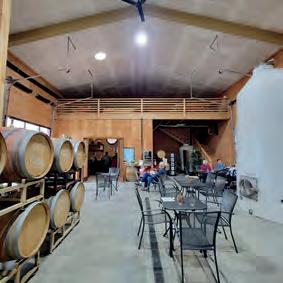



Alexis, who makes the wines with the help of assistant winemaker Teddi Fuller, has expanded the winery’s offerings over the past few years. Along with a range of reds and whites, plus a rosé, at Fuller’s urging they started making sparkling wine, including a pét-nat that consistently wins awards. He’s also concentrated his winemaking efforts on producing wine with grapes grown solely within the Gorge and Klickitat County.
Steeped in the ecosystem of the vineyard as much as what happens to the grapes after harvest, Alexis can enumerate specific growing conditions of each of the vineyards he buys grapes from — including his own organically certified estate vineyard where he grows Syrah, Viognier, Roussanne and Marsanne.
But as much as he can talk the talk of an experienced vigneron (a term he prefers to winemaker because it speaks to his focus on the cultivation of the grapes throughout the season), his goal is for people to simply enjoy his wine. “The varietal shouldn’t matter,” he said. “It’s much more about drinking wine with your friends. I want my wine to be another guest at the table that brings conversation.”
For the Pouillons, the wine bistro brings two of their passions together. “It lets us show how the wines pair with food, and how important food and wine are together,” Alexis said. Enjoying them in this beautiful setting at the confluence of two rivers is the perfect finish.
To learn more, go to domainepouillon.com.




Story & photos by David Hanson


ON MARCH 28, AARON STANTON, executive director of the Mt. Adams Institute (MAI) in Trout Lake, Washington, laid off five of his nine staff. Being spring, it was the time of year when MAI’s flagship program, VetsWork, would begin enrolling veterans for internships in natural resource management. Typically, they enroll 35 to 40 men and women in public lands positions doing trail and campground maintenance, fire reduction and invasive species removal, among other work. This year MAI will enroll only 11 veterans.
The staff reduction at MAI, funded in part by federal agreements and the AmeriCorps program, is a result of sweeping cuts made by the Trump Administration’s Department of Government Efficiency (DOGE), directed by Elon Musk. The cuts have been broad and immediate, a combination of incentivized resignations and outright firings. The firing notices arrive in emails from Washington, D.C., rather than via the traditional chain of command administered through local Ranger District offices.
MAI is a non-profit that augments the capacity of federal land agencies to accomplish management objectives while supporting the career transitions of U.S. military veterans and young adults. The cuts at MAI are a drop in the bucket of what has happened almost overnight across the country. DOGE cut roughly 2,000 Forest Service jobs, 800 Bureau of Land Management jobs, and 1,000 National Park Service positions in March.
The Columbia Gorge is blanketed in public lands, from the 85-mile-long Columbia River Gorge National Scenic Area to the four districts that encircle Mount Hood to the massive Gifford Pinchot National Forest around Mount Adams. The story of our public lands has been evolving for decades, beginning in the 1930s when, as part of the New Deal, the Civilian Conservation Corps hired young adults to develop trails, clear roads and build some of the iconic cabins, lodges and lookout towers we still use today.
Thirty-one years ago, after the long, bitter Timber Wars pitted logging companies against environmentalists, the Northwest Forest Plan shifted the focus of our public lands from timber and fire mitigation to an ecologically based approach with an emphasis on recreational value and consideration for endangered species. Agencies were faced with a wider aperture of management responsibilities and, over the years that followed, less funding and fewer resources to accomplish the broadened mission.
I spoke to almost a dozen Gorge residents for this article and most asked to remain anonymous, which is itself newsworthy. In almost ten years of writing for The Gorge Magazine I’ve never had such requests for anonymity. The U.S. Forest Service media relations representative wasn’t allowed to answer my questions; she sent the queries to D.C. and I received an official response which read, in part: Secretary Rollins fully supports the President’s directive to improve government, eliminate inefficiencies and strengthen USDA’s many services to the American people. Protecting the people and communities we serve, as well as the infrastructure, businesses and resources they depend on to grow and thrive, remains a top priority for the USDA and the Forest Service.
Gary Asbridge is a retired fish biologist who began work with the Forest Service in 1990, four years before the Northwest Forest Plan was enacted.
“By the late 1990s I saw changes,” he says. “There were more ‘-ologists’ hired. Biologists, hydrologists, soil scientists, more recreational positions. In my experience, throughout my career, there was always more work to be done than there was capacity to meet it. I’ve heard the new administration wants to focus more on timber and oil-and-gas. If that happens, I believe there would be less capacity to pursue other projects or programs.”

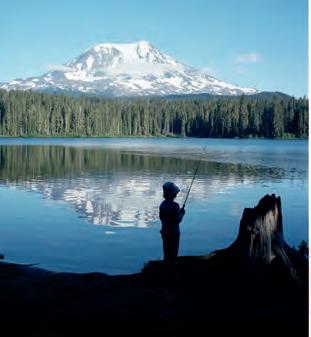

Retired Forest Service hydrologist Rick Ragan has seen where reduced staffing and resources can lead. Lost Lake Campground and its amenities are managed by the private, for-profit Lost Lake Resort despite being on Forest Service land. Another private concessionaire, Alaska Recreational Management, operates the Trillium Lake campground. Ragan worries that privatization is the goal with these cuts. “This anti-government movement is a self-fulfilling prophecy: cut the government to the point where it can’t really function, then privatize. They’ve been doing that for a while. Now it’s just gone turbo speed.”
I spoke with a mid-career Forest Service staffer who took deferred resignation. He spoke on the condition of anonymity, as his severance period ends in the fall and he fears he could lose benefits if his name is in the media.

“The Gifford Pinchot Forest Service lost over two-thirds of its field-going staff,” he told me, “and those are people that mostly collect garbage, clean toilets, maintain facilities and clear trails. We know for sure that the staff that brought a 10-yard dumpster of garbage out of the forest each week won’t be there this summer. To become a Forest Service permanent employee is challenging. It often requires a college degree and four years of temporary employment with no benefits, a seasonal schedule and $17 per hour. You need an off-season job to make it work. It’s a niche thing to be a wilderness ranger or biologist or trail crew lead. I have a masters in this field. I want my job, but it’s not worth it to see my program crumble and staff disappear. I had a good run, though.”
In one sense, this moment could feel like a potential inflection point, a pendulum shift toward a pre-Northwest Forest Plan era when public lands were managed more for timber production and fire mitigation. One of the Executive Orders mandated through the USDA is a 25 percent increase in timber production over 4 to 5 years.
A forester from the Gorge, who also wished to remain anonymous, echoed sentiments of a number of those interviewed who feel like a renewed investment in timber harvesting guided by science-based fuels reduction measures would be a safe, sustainable approach. A warmer, drier climate and over-stocked forests are a dangerous recipe, and logging can be beneficial. But efficient, sustainable forestry requires money, expertise and labor, much of which is being sidelined, fired or scared into retirement.
“I’m skeptical that if you’re gutting federal government,” the forester told me, “then who is there to do inventory of what’s on the shelf? If no one can provide an accurate assessment of the costs and value of the public forests, then companies aren’t going to invest in the timber.”
The environmental safeguards established with the Northwest Forest Plan — NEPA studies required by the National Environmental Policy Act being paramount — remain, so moving forward in a responsible manner has checks and balances.



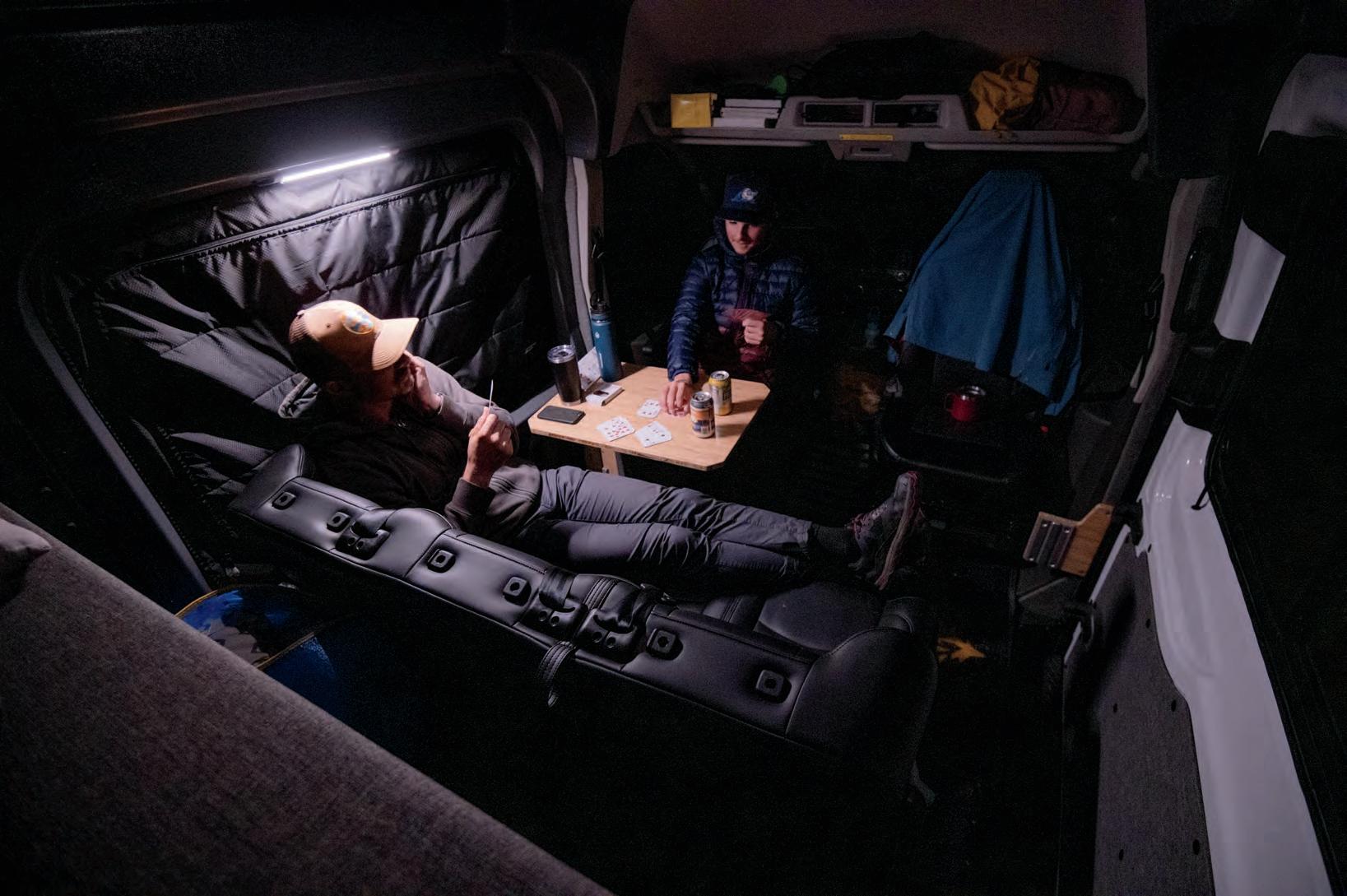
“ e question for me,” the forester told me, “is are they going to try to gut the Endangered Species Act (ESA), the Clean Water Act and these law-of-the-land guidelines that we all agree are fundamental and permanent? If they just say screw NEPA and ESA, then they could just do whatever they want and send loggers into the woods.”
Aaron Stanton at MAI recognizes that in the short term, the appointees in D.C. seem to understand the optics of the situation they’ve created with public lands layo s.
“What the public sees are largely recreational impacts so that’s where e orts will be shifted,” Stanton says. “So instead of a biologist working on a project necessary for the health of the forest, they might be working on a bathroom to keep it clean and safe. e irony with DOGE is that there’s no analysis of e ciency vs. ine ciency. It’s not just downsizing the federal government. It’s downsizing organizations like us that work directly on local lands, but also for-pro ts that rely on grants. Just cutting the way they are doing is creating ine ciencies that will ultimately cost more down the road.”
Asbridge, the retired sh biologist, agreed. “It’s like they are taking a machete to the garden instead of some hand pruners,” he told me. “ e initial rings were probationary people, but a lot of seasoned employees are taking the early retirement option. ese people are the cream of the crop. ey’ve given their careers to the service of the American public. One friend had planned to work another 5 to 10 years. She said her value to the agency was really coming

into fruition given her training and experience, and now was in a position to fully pay back the agency’s investment and belief in her. She was really getting things done, and now we’re losing that.
“It’s a shame,” he added. “I don’t know if that was what was intended.”
David Hanson is a writer, photographer and video producer based in Hood River. Find his editorial/commercial work at ModocStories.com and weddings at CascadiaStudios.com.













Carol
Proctor
| Mosier,
Buena Vista Ct #2 | Goldendale, WA


Dividable Buildable Lot
1.31 acres outside city limits in the urban growth area. Currently there are 7 manufactured homes, 3 owned and rented by seller & 4 owned by individuals.
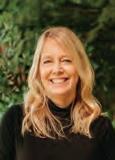
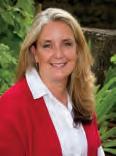
541-490-3156


Once-in-a-Lifetime Generational Property! 85 Acres of Unmatched Privacy and Natural Beauty. Located off a well maintained County, dead-end road. This incredible 85-acre property offers ultimate seclusion while still being only 3 miles from downtown Mosier!
$1,500,000 | RMLS# 24145467
| RMLS# 543048437


This


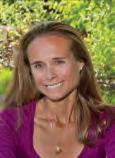







gar! Separate guest quarters, 1500sqft vintage farmhouse, 2000 sq ft shop. $1,699,000 | RMLS# 24329114
This 3 bed/2 bath well cared for 1992 Fleetwood double-wide set on 3.34 park-like acres is just waiting for you to make it your own. It sits above the White Salmon River over a feature known as Triple Drop.
$575,000 | RMLS# 24521205
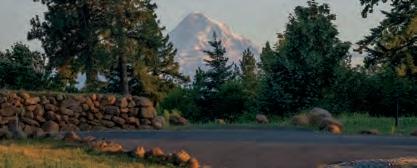




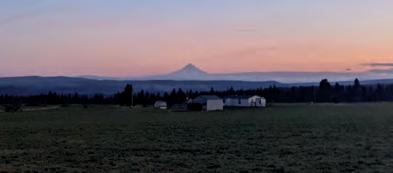

Mount Hood View Property
nestled on over 4 acres of peaceful, natural beauty including more than an acre of producing Anjou and Bartlett pear trees. If you’re looking for a home with personality, Evans Creek out your back door.
This 5-acre level property with a beautiful wooded backdrop is a blank slate ready to be developed. Underground power is at the property line, to be well, to be septic. Standard septic perc test conducted in 2021.
$725,000 | RMLS# 210434501
$85,000 | RMLS# 24611631


in 2011 with over 200 ft. of Low Bank Hood River Frontage right out your front door. This idyllic paradise is situated on 3.39 secluded acres only about 10 min from Hood River.
$1,500,000 | RMLS# 24294702
4125 Green Mountain Dr| Parkdale, OR


& some with views all the way to the HR Bridge. 6 lots available


Story and photos by Christopher Van Tilburg
THE HIGH ALPINE GLACIERS ARE VAST, AMBIGUOUS AND FORMIDABLE to those who have not explored these giant masses of ice. As climbers, we regard these daunting, disquieting flows with an uneasy mix of titillation and circumspection. Sometimes, the ice is hard and slippery under ski climbing skins. When glaciers are too steep or firm for skiing uphill, we attach ski crampons for extra grip. For even steeper and harder slopes, we shuck skis and affix boot crampons that grab the ice.
This is the north slope of Mount Hood and early spring is traditionally the beginning of volcano climbing season, marked by good weather and consolidated snow. And it used to be the beginning of rescue season, which typically ran through summer. But the Hood River County Sheriff’s Office (HRCSO) and the Hood River Crag Rats are already busy by spring — the former responsible for all search and rescue (SAR) calls in the county, the latter being the oldest mountain rescue team in the nation, established in 1926. Now we no longer have a rescue season. We are busy all year long on this mountain of mayhem.
Mount Hood is a giant, solitary stratovolcano with 12 named glaciers (although one has been downgraded to a snowfield and a second has shrunk to a clump of ice). An active volcano, the glaciers are bedecked with steaming fumaroles, gushing waterfalls, bucolic outflow streams and craggy cliffs of gray andesite.
Reportedly this peak was originally called Wy’East by the indigenous Multnomah band of the Chinookan people who lived near what is now Portland. The mountain was given its current moniker on October 29, 1792, when British Lieutenant William Broughton sailed his ship up the Columbia River estuary and spied the snowclad volcano from the northwest. He named it after British Admiral Samuel Hood, despite no documentation that the admiral had ever seen this peak.
Notwithstanding the possibility of an undocumented ascent, the first claimed summit was by European settler Thomas Dryer, Portlander Wells Lake and an unnamed American Indian. The trio traveled from Portland via horseback to White River and summitted on August 8, 1854. They used primitive boot crampons called “creepers,” iron staffs with hooks and manila farm rope. Because Dryer documented the trip in his own newspaper, Weekly Oregonian, many discredit him. The second ascent — or first for those who disbelieve Dryer — was completed by four Portlanders led by Henry Pittock on August 6, 1857, as reported in the Democratic Standard. By the end of the 19th century, mountaineers were climbing the peak more regularly. And with mountain climbing came mountain accidents. Thus, Crag Rats were spawned by mountaineers with a passion for the peak and a desire to save lives.



Today, the HRCSO sees more than 70 SAR missions annually, roughly the fifth busiest county of the state’s 36, according to Scott Lucas, director of the Office of Emergency Management. Of these missions, Crag Rats are deployed on several score per year on the mountain and in the Columbia River Gorge.


After averaging 30 missions annually for a decade, in 2022 Crag Rats had a record year with nearly 45 missions and 60 days of rescues. Beyond rescues, Crag Rats have 30 to 40 trainings per year, equipment upkeep, two tracked snow vehicles to maintain, two buildings to manage and a non-profit to run. Sheriff Matt English is busier: he calls upon another team, Pacific Northwest Search and Rescue, and a cadre of deputies who manage snowmobiles, all-terrain vehicles, a snowcat, a marine program and a Piper Cub airplane. Crag Rats have assisted missions on other Cascade peaks as well, and in neighboring Wasco, Clackamas and Multnomah counties.
So, what’s happening on Mount Hood after rescues surged in 2013, skyrocketed in 2022 and never really slowed down?
We have perennial risks on this volcano. Falling ice, rime and rocks peel off and pelt climbers on the popular South Side routes on what is likely the most-climbed glaciated peak in the world. Steep, icy slopes cause “slides for life,” a frequent cause of fatalities. “Chicken heads,” surface globules of ice shaped by cold, moisturerich winds make climbing and skiing deadly. The mountain has holes: crevasses, bergschrunds, fumaroles, glide cracks. Avalanches occur













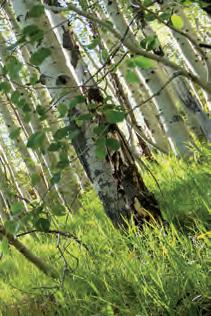




STAND UP PADDLING
Every Saturday in July & August, 10am12pm
@ Wylde Wind & Water Event Site Center (*Except Aug 16)
All ages & experience levels welcome. Equipment provided INTRO TO WINGFOIL
Every Thursday in July & August, 5:30-7:30pm @ The Hook
All ages & experience levels welcome. Equipment Provided
FIONA FRIDAY FUNDAY
Friday, August 25! A day to play with Fiona Wylde & Pro Athletes on the water! SUP, Swimming, Games! th
Kids 6-17 years old 11am-1pm @ WW&W Event Site. Equipment provided July 5 & 19, Aug 2 2-4pm
WW&W Event Site Center
All ages, equipment not provided. 541-399-0475

English & Español 501(c)(3) Non-Profit www.wyldewindandwater.org


somewhat regularly on Zig Zag Glacier at Illumination Saddle and Coleman Glacier, both popular ski destinations.
On top of all that, one gargantuan dragon lurks: weather. Unlike continental ranges, Mount Hood is a solo peak with a prominence of 7,706 feet above a sea of Douglas r-clad hills. e monolith collects weather like a magnet. No trees exist above Timberline so in a whiteout, climbers get stuck in the “Mount Hood Triangle,” a phenomenon in which climbers descending the south side erroneously downclimb the fall line, leading them down Zig Zag Glacier to Mississippi Head, a sheer cli (one needs to follow magnetic south on a compass, a subtle, awkward sidehill trek back to Timberline Lodge).
But these omnipresent objective hazards are not solely responsible for accidents. We also have the thorny human factor.
An unprecedented number of people are climbing, skiing, snowshoeing, hiking and running Mount Hood and ocking to the Columbia River Gorge. Mount Hood is no longer a seasonal volcano climb in spring and summer, and the Gorge trails are no longer a three-season playground. It’s full-on, all year long.
Sometimes people set out unprepared and ill-equipped. ey climb with improper footwear, no crampons and no safety equipment. Some have the correct gear but don’t know how to use it. Technology, including satellite-based navigation devices and phone apps, requires training and experience. e internet is both bene cial and hazardous. A plethora of information exists for trip planning, including real-time telemetry for temperature, precipitation and wind. However, trip reports on social media may be inaccurate or misrepresentative, minimizing risk in the search for self-grati cation.
Notwithstanding the objective hazards and subjective human factors, a grander issue exists. e mountain itself is changing, perhaps in part by the natural course of the earth and in part by humans: melting glaciers, clearcut and burned forests, roads, dammed streams, depleted aquifers, smoggy and smoky air. is mountain, like the world, is in crisis.
e Eliot Glacier, the mountain’s largest by volume, dominates the north side. Named after 19th-century mountaineer Dr. omas Eliot, the glacier has a volume of 73,000 acre feet, almost double the next largest, and is anked by massive moraines of rocks and boulders. At one time the glacier’s tongue owed to the 5,500-foot elevation; it’s now receded to around 7,000 feet.
Eliot Glacier was rst photographed in 1901. Measurements of recession started in the 1940s, were updated by Portland State University faculty in 2007, and recon rmed in 2023



The Crag Rats implement a technical rope-raising system on Eliot Glacier for a crevasse extrication.
and 2024 by PSU glaciologist Kiya Riverman. From the Crag Rats’ search base Cloud Cap Inn, Riverman and a squad of grad students measured the glacier using radar and found it to be receding at a rate of one meter per year.
To the east of the Eliot lies an expansive, crevasse-free snowfield called Cooper Spur and the Newton Clark Glacier, named after a local surveyor. With the largest surface area at 491 acres, the Newton Clark is shrinking, too: it lost 32 percent of its area from 1907 to 2004.
To the west of Eliot lies Langille Glacier, named for mountain guiding brothers. Further west, the Coe Glacier, named after early Hood River white European settlers, is riddled with giant serac fields. The Ladd Glacier, named for climber William Ladd, builder of Cloud Cap Inn, has mostly melted, losing 37 percent of its volume from 1907 to 2004. And the former Glisan Glacier, named after climber Rodney Glisan, existed in 2003 but by 2020 had melted to a bit of ice.
The remaining glaciers encapsulate the south hemisphere of the mountain. From east to west are White River, Coalman (climber
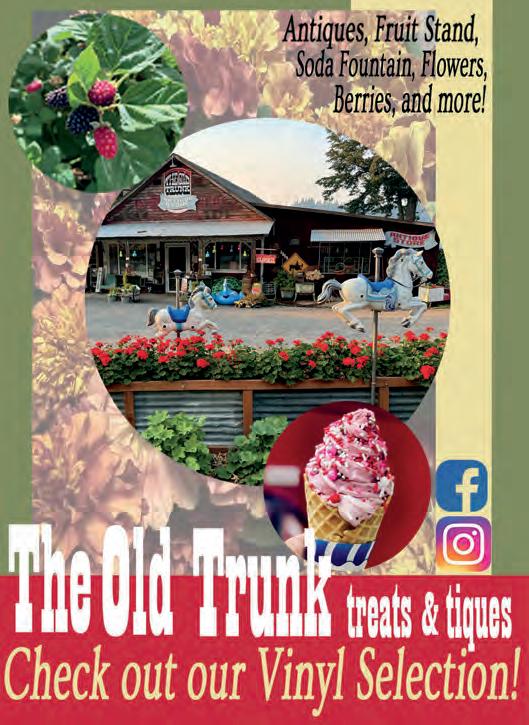

Elija Coalman logged a reported 586 summits), Palmer snowfield (climber Joe Palmer’s namesake stopped flowing in 1980 and has been downgraded to a snowfield), ZigZag, Reid and Sandy. These glaciers are enchanting to climb and ski, but the impact of climate change is felt under our skis and in our communities. For Crag Rats, the melting snow and ice means we have longer approaches on rocks, dirt and boulders. More importantly for the community, these glaciers, along with annual snowfall, supply us with drinking and irrigation water. Alas, this is a bigger problem than the one that’s imminent as I finish this paragraph: the phone buzzing next to me with another rescue call, “Climber injured, Wy’East Face.”
I don’t know what the future holds for Mount Hood. But I can say confidently that Crag Rats and HRCSO will continue to save lives. You can help, too. Wear proper footwear. Be prepared for an unexpected night out. Learn navigation with your cell phone mapping app or a GPS locator. Carry basic emergency supplies like a headlamp, a spare cell phone battery and extra clothing, food and water. Stay on the trail. Don’t attempt terrain beyond your skills. Hire a guide. Turn back early when things get dicey. If you want to post on social media, consider objective information for other climbers that accurately represents the beauty and the danger, the reward and the risk.
Christopher Van Tilburg is a Hood River physician, 25-year veteran of Hood River Crag Rats, and author of Crisis on Mount Hood: Stories from 100 Years of Mountain Rescue, published in May by Mountaineers Books. For more detailed information, go to linktr.ee/ christophervantilburg.



AS A REGULAR ON HOOD RIVER’S INDIAN CREEK TRAIL, I delight in the changes that mark every season along this path that winds through the city. e sparse winter landscape morphs in an explosion of lush growth come spring, with wild owers and skunk cabbage vying for attention. Long summer days invite late evening walks in the twilight, and fall brings a kaleidoscope of color. I’ve been traversing this trail for years, dating back to when there was a single segment along the old wooden ume that once carried water downtown from Indian Creek. I walk or run this trail almost every day and I still feel a sense of wonder each time, even though every step feels familiar. en in April, I was on my usual trail run when something ashed in my peripheral vision as I rounded a corner. I backtracked a few steps and there it was: a signpost with a poem inscribed over a beautiful photograph. Light ltered down through the trees, dancing on the metal sign. It felt magical in the way something unexpected can feel. As I continued along the trail, I came to another one, and then one more before I turned around. I vaguely recalled hearing something about this, but now that I’d seen them, I wanted to know how they got here, and why.
It turns out the signs are a passion project initiated by longtime Hood River resident Paul Woolery, a retired therapist. He was inspired after coming across similar signs in Washington’s Olympic National Park while exploring trails there with his wife, Tina Castañares.
“We came upon these poetry signs on several di erent trails,” Woolery said. “I thought it was just a wonderful thing.” Woolery learned that the signs are installed annually by the North Olympic Library System, in partnership with the national park and the North Olympic Land Trust. Known as the NOLS Poetry Walks, the signs go up in April to celebrate National Poetry Month and remain through the end of May.

“I decided I wanted to bring something like that to Hood River,” Woolery said. “ e Indian Creek Trail seemed like a natural place for it.” His vision took the poetry signs one step further with the addition of a photograph to go with each poem.
He approached Rachael Fox, director of the Hood River County Library, and Mark Hickock, head of the Hood River County

Parks and Recreation District which oversees the Indian Creek Trail. ey both o ered support for the project, although neither is involved nancially.
en Woolery formed a committee made up of poets and writers, or lovers of poetry. With his guidance, they came up with a process to select the poems whereby each of the seven members nominated ve poems. en, through a blind vote, everyone assigned points to their favorite ones.
“I wanted the poems to be nature-themed and re ect the cultural and ethnic history of the Hood River Valley,” he said. Fourteen poems made the nal cut. Hickock had initially said they could do 12 signs along the trail, but when Woolery appealed to him for two more, he agreed.
For the background images, Woolery started with local landscape photographers Brian Chambers and Peter Marbach, whom he knew. ey recommended three others — Paloma Ayala, Cate Hotchkiss and Linda Steider. “ ey’ve all been so enthusiastic and generous,” Woolery said.
Matching the background images to the poems was challenging, according to Woolery, because he wanted each photograph to correspond to the poem’s theme or content. Some were an easy match while others — particularly the more abstract poems — proved harder. But those were especially rewarding, he said, “because the process compelled me to read the poems over and over, which kept deepening my appreciation of them.”
Most of the images came from each photographer’s catalog of images. For a poem entitled Canine Superpowers, however, photographer Cate Hotchkiss took the time to create a special image of her dog playing in the water.
e signs were made locally at Print It/Sign Media.
Woolery walked the trail with Hickock to nalize placement of the signs. “He was in charge of saying yes or no to locations I had previously scouted,” Woolery said. e signs were allowed on two






sections of the trail, the southside extension and the trail’s westernmost segment.
Once the placements were decided, Woolery intentionally matched poems and locations. “Most of them called for a particular location,” he said. A poem by Joy Harjo that invites people to step away from their daily activity and tune into nature was placed at the trail entrance on the west side. “I thought it was a good introductory poem,” Woolery said. Another entitled Vigil by Native American Earle ompson about salmon shing and the loss of Celilo Falls sits where visitors can read it looking out over the Hood River in the direction of the former falls. Woolery placed Canine Superpowers on the trail’s west segment next to the creek where dogs love to play.
“It’s possible to miss them,” he said of the signs. “I ride my bike on the trail a lot and I’ve ridden right by them — which actually was part of the intentional design. I didn’t want them to leap out at people.”
e Indian Creek Poetry Walk will re-


main in place through September. Woolery’s hope is that it will become an annual event, with sponsorships to help cover costs. “I’ve tried to involve as many people as possible — to create a sense of ownership — and I think it will naturally grow that way,” he said.
“It’s really been a joy to put the whole project together,” he added, “to create a beautiful gift for the community.”
To learn more, go to hoodriverlibrary.org











Guided tours for individuals, groups, families, or couples. Including waterfalls, wild owers, wineries, breweries, trail hikes, scenic drives and more. Sit back and relax as we explore the hidden treasures of the Columbia River Gorge National Scenic Area.
503-349-1323
martinsgorgetours.com

Stunning views, spacious guestrooms on the Columbia River at the Bridge of the Gods. Close to waterfalls and outdoor activities. Complimentary hot breakfast, pool, spa, tness room.
541-374-8777 • 800-595-7108
bwcolumbiariverinn.com
735 WaNaPa St. • Cascade Locks

Your structural experts for e Gorge! From new construction to remodels, we do it all. Contact us today for drawings to be used for permitting and construction!
541-716-1381 • stroikaengineering.com
390 Evergreen Dr., Ste C-5 • N. Bonneville

Fast, friendly family dining for breakfast and lunch, plus spectacular views of the Gorge and Bridge of the Gods.
Burgers • Sandwiches • Salads • Soups
Baskets • Specials • Desserts
Gi Shop • Historic Artifacts
541-374-8477 • bridgesidedining.com
745 NW Wa Na Pa St. • Cascade Locks









Wander along the pathways of our retail garden nursery and nd majestic trees, unique shrubs, and an abundance of owers. Our gi shop is lled with handmade treasures and a variety of pottery. We also carry barks, composts and rock.
509-427-0010 • gatorcreekgardens.com
81 Hot Springs Avenue • Carson
Experience our custom A-frame cabins, including two featuring outdoor soaking bathtubs and private courtyards. With Columbia River views and tranquil grounds, we o er a place to unwind and make memories in downtown Stevenson.
509-901-1070 • artblisshotel.com
37 NW 2nd Street • Stevenson
Our museum is where regional stories come alive through art, artifacts, and exhibits. Embark on a journey through time and discover what makes the Gorge a place of enduring beauty and cultural signi cance.
509-427-8211
columbiagorgemuseum.org
990 SW Rock Creek Dr. • Stevenson
Custom Home Kits: Conventional, Post & Beam, Timber or Log hybrids. Over 600+ plans and designs on website. Free dra ing and no charge for modi cations or custom plans. Panelized exterior walls. Price guarantees. Model home by appointment. 800-728-4474 • cedardesigns.com info@cedardesigns.com • Carson

CELL REGEN OFFERS HIGH-TECH TREATMENTS AIMED AT FUNCTIONAL WELLNESS

SKIING OFF CLIFFS was second nature to Dr. Bryan Call, right up until the time he crashed after attempting a cliff jump near Grand Targhee Resort in Wyoming. Executing a slow, elongated front flip off a cliff was something he’d done countless times before. In fact, he’d done it three times already the day of his crash. With a recent sponsorship to his name, and the dream of becoming a professional skier, Call soared off the cliff for a fourth time, hoping to perfect the move. Instead, he slammed into the snow nearly a hundred feet below.
Call was carted off the mountain, initially unable to walk. With no money to his name, he turned to his extended family of physicians for help. “I went the discount family-exam route, as opposed to going to the hospital like I should have,” he said. His grandfather, a cardiologist, declared that he’d separated his ribs and prescribed painkillers. “His literal quote was, ‘Don’t be stupid anymore. You’ll be sore for six months, but you’ll be fine after that,’” Call said.
He was 24 when the accident happened. Three and a half years later, after extensive physical therapy, Call was still in a lot of pain. “I couldn’t do any of my normal things,” he said — including skiing, playing football or doing martial arts, all of which were his passions. His wife had been urging him for years to go to a chiropractor or at least try massage therapy. “I’d always sort of openly mocked her,” said Call, who recounts growing up in a


family of conventional doctors steeped in Western medicine. “It was all medical, all the time. Anything alternative was kind of demonized.” But the pain and lifestyle restrictions — plus an o er for a free chiropractic exam — convinced him to give it a try. He remained skeptical throughout the exam, but consented to having a series of x-rays done. “When the doctor pulled up the images, he said, ‘Well, my rst question is, when did you break your back?’” Call said he laughed out loud, feeling like his doubts had been
•
•






“My pain has gone down to zero. It’s like my body has forgotten there was pain there.” Mahani A.
recovery


Skyline Health is proud to share with you our newly expanded Emergency Department. This innova�ve space gives our talented staff a facility equaling their exper�se and commitment.
And more importantly, our friends and neighbors are able to obtain life-saving care in a state-of-the-art facility designed especially for them.










Body sculpting, left. PEMF (pulsed electromagnetic field therapy), right, uses low-frequency electromagnetic waves to stimulate and promote the body’s natural healing processes. It’s often used for pain and injury-recovery as well as to treat stress and sleep disorders.
validated. “I was thinking, of course this guy’s a quack. I never broke my back. I would have known if I broke my back.” He said as much to the chiropractor, who replied, “Well, your spine disagrees with you,” and pointed to five places where he’d fractured vertebrae.
Immediately, Call knew exactly when it had happened. “And so, I submitted to his treatments, and four weeks later I felt about 70 to 80 percent better than I had for three and a half years,” he said. “I almost felt normal.” It was a revelation for Call, and he decided to go to school to become a chiropractor himself. Along with regular coursework at Palmer College of Chiropractic in Florida, Call dove into research and data. “I love to read, and I became obsessed with knowing more,” he said. “It kind of drove me down the path of more alternatives than even the typical alternative medicine route.”
After chiropractic school, Call partnered with an MD, a nurse practitioner and a physical therapist to open a stem cell center in Florida. “We did stem cell injections and physical therapy rehab, combined with chiropractic treatments,” he said, adding that it was a “beautiful combination” of treatment modalities that proved effective for many patients. After a few years, Call and his wife — having just had their third child — wanted to move back to the Northwest to be closer to family. A friend invited them to visit Hood River, and they loved it immediately. “We packed it all up and drove out here,” he said. “We knew two people in town.”
That was late fall of 2019, and after settling in and finally feeling ready to get out and meet people, the pandemic hit. It stymied them not just socially, but professionally as well. Call had plans to open a clinic similar to the one he had in Florida, but the economic uncertainty caused an investor to back out and the plan was tabled.
Call decided to pivot. Drawing on his own research and experience with traumatic brain injury (he’s suffered more than two dozen concussions over years of playing football, skiing and doing mixed martial arts), he began investing in equipment that he’d found helpful in his own treatments. “I found neurofeedback therapy. I found hyperbaric. I found transcranial magnetic therapy,” he said. “Everything stemmed back to systemic and total inflammatory reactions. How can we affect global inflammation? These are ways we can combat
brain.”



















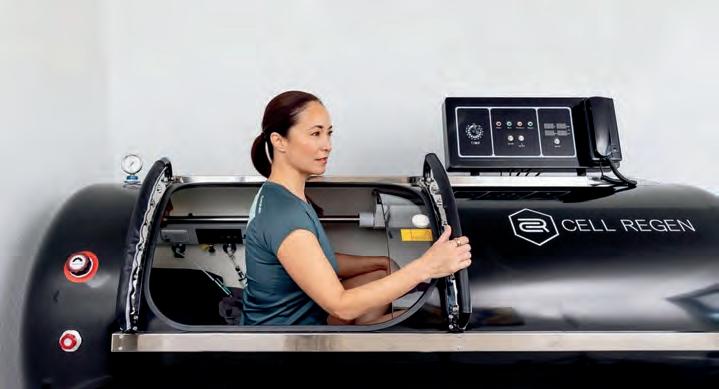
Call launched his functional wellness center, Cell Regen, in fall 2020. “It was out of my own personal pain and journey that we kind of morphed to create this,” he said. “I regularly use everything in my o ce.” Treatments at Cell Regen include Pulsed Electromagnetic Field erapy (PEMF), red light therapy and hyperbaric oxygen therapy as well as neurofeedback, treatment of neuropathy, and body sculpting with the aim of building muscle. Call also continues to o er chiropractic care, but on a more case-by-case basis. “ ere are so many good chiropractors in town. But I’ll take interesting and unique cases. I love to Sherlock Holmes things, so the challenging stu becomes more interesting for me.”
When Melanie Strong arrived at Call’s o ce three years ago, she was seeking not chiropractic care but hyperbaric oxygen therapy. e Hood River resident was just over a month out from emergency brain surgery after a bike accident left her with a subdural hematoma.
“ ey wheel you out of the hospital with very little information about what to do for your recovery,” Strong said. Fortunately, in her role as co-founder and managing partner at Next Ventures, an early stage investing rm, she was connected with innovative companies and technologies related to health and wellness. Several medical professionals recommended hyperbaric oxygen therapy (HBOT) to treat her traumatic brain injury.
“I was looking for something to buck the stats suggesting that I would always be sort of cognitively impaired,” Strong said. As soon as her incision healed, she met with Call and started a protocol of one-hour sessions in the hyperbaric chamber twice a week.
e goal of HBOT is to get more oxygen to tissues damaged by disease or injury. Inside a hyperbaric oxygen chamber, the pressure is increased two to three times higher than normal air pressure. Simply breathing inside a hyperbaric oxygen chamber allows the lungs to gather much more oxygen than is possible at normal air pressure, in turn increasing the amount of oxygen in the blood. Increased oxygenation can help the body rebuild cells, repair damaged tissue, create new blood vessels, and decrease swelling and in ammation.
According to the Mayo Clinic, HBOT is used for conditions ranging from carbon monoxide poisoning and non-healing wounds to tissue-saving treatments and low red blood cell counts. It’s also increasingly being studied and used to treat TBI and stroke.
Strong looked at research that showed bene ts for TBI patients with 30 to 40 sessions of HBOT. She completed about 40 over the course of a year. “I was game to try and do everything I could to recover well, and I really do believe Bryan was key to my recovery,” said Strong, whose neurosurgeon had told her there was a 90 percent chance of having some level of brain damage from her injury. “It was life changing,” she added. Strong also did other treatments at Cell Regen, including PEMF and red light therapy. She’s fully recovered from her brain injury and says she feels even better than she did before her accident.


DR. LOYD grew up in a missionary family and experienced various cultures across University of Oklahoma he continued his training at Wake Forest University and He learned about the beauty of the Gorge while working in Portland. His medical before moving to the Gorge and joining Hood River Dermatology. He is board dermatopathology.
His interest in returning to the area was sparked by the plethora of outdoor recreational Cascades. He looks forward to enjoying these activities with his 2 daughters. hiking, backcountry skiing, biking and kiting.
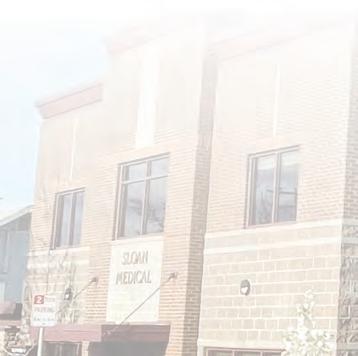
HOOD RIVER DERMATOLOGY was established 25 years ago by Dr. Sloan and has grown to include 6 providers. We provide comprehensive dermatologic care based on the latest advances in prevention, diagnosis and treatment.
Living, working and recreating in the beautiful Columbia River Gorge can create challenges for skin that we deeply understand. From newborn rashes and adolescent break outs to hair loss and skin cancer, we pride ourselves on providing excellent lifelong care.
With Dr. Loyd we provide Mohs surgical treatments for complex cancer, including facial reconstruction if needed. Cosmetic services are provided by experts in skin care, using several advanced laser and light devices. Our newest device, Scarlet, combines radiofrequency with robotic microneedling to produce a nonsurgical face lift.

We are excited to introduce Dr. Riter, an experienced and esteemed physician with Gorge roots and academic association with Oregon Health Sciences University. She joined our practice this year and will help us grow in the next 25 years.

Hours: Mon-Fri 8:30 AM–5 PM 917 11th Street, Hood River, OR 97031 ph: 541.386.2517 fx: 541.386.1919



For Call, Strong’s recovery was notable but not surprising. After 36 to 40 sessions, “there’s permanently increased blood flow to tissue that may have been minorly or majorly hypoxic,” he said. “For Melanie, the hyperbaric oxygen treatment was a major improvement for her, and it worked as expected.”
Helping Strong recover and get back to her professional and recreational life — she’s an avid mountain biker — is what Call loves about his work. “I’m an adventurer,” he said. “I love scaling mountains and hiking and skiing and rock climbing — life is the greatest adventure we could ever have. That was taken from me when I injured my back. For all those years, I was unable to live the life that I wanted to.” Along with physical pain and disability, it left emotional scars, he said.
“My life’s mission is to help others whose physical restriction might be impeding their greatest life adventures,” he said. It took 13 years for Call to get back on a


pair of skis after his accident, but once he did, he quickly regained the confidence to do big jumps again. These days, he calls himself a calculated risk taker. “If I don’t feel 150-percent confident that it’s something I can do easily, I don’t even attempt it,” he said. With three kids and a business to run, “I have a lot of stuff that’s more important than my little moment of adrenaline,” he added with a laugh.
“But if I can help someone to live their greatest adventure, that’s my purpose,” Call said. “That’s what we’re here for.”
To learn more, go to cellregenwellness.com.


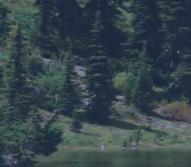




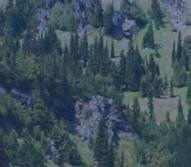





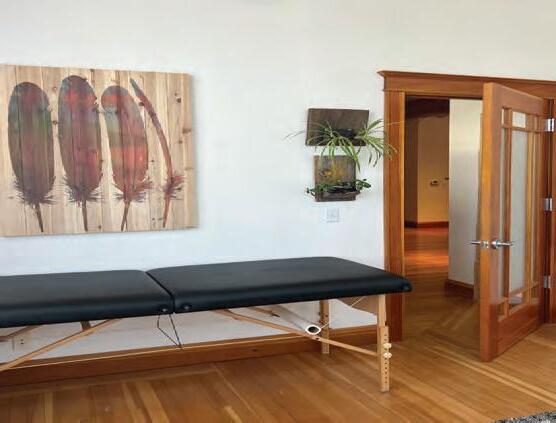














Naturopathic Medicine & Primary Care • Medical Weight
Thyroid Conditions • Menopause & Women's Health • Men's Health & Testosterone Replacement
Bio-Identical Hormone Replacement Therapies • Biote Hormone Pellet Therapy
Cardiovascular Disease & Diabetes Management & Prevention • Autoimmune Conditions
Chronic Gastrointestinal Disorders • Vitamin IV Therapies & Injections
Acupuncture, Cupping & Chinese Medicine • Naturopathic Pediatrics
Recipe by KACIE MCMACKIN & PETRA KNAPP
• 1 bunch broccolini, stems chopped small, florets cut into small, bite-size bits
• 1 small head radicchio, thinly sliced or torn
• 1 small bunch curly kale, torn
• 1 small bunch lacinato kale, torn
• 1 large shallot, thinly sliced
• rustic loaf for croutons (optional)
• Parmesan cheese, finely grated
• Aleppo pepper
• olive oil
• kosher salt
• 2/3 cup extra virgin olive oil
• 1/3 cup lemon juice
• 1 egg yolk
• 1 Tbsp. Dijon mustard
• 1 tsp. coconut aminos
• 1 clove garlic, minced
• 1 heaping tsp. nutritional yeast
• 1 Tbsp. apple cider vinegar
• 4 anchovy fillets, minced
• kosher salt
• Aleppo pepper

Petra Knapp, who owns Hood River catering company Native Provisions, recently brought a version of this salad to a potluck gathering. It is one of those dishes that is greater than the sum of its parts — savory and satisfying, bright and unexpected. We decided to re-create it together and share it because it was just too good not to. This salad would be lovely served and topped with a fried egg, cauliflower steak or roasted chicken.
Add all of the dressing ingredients, except the olive oil, to a medium bowl and whisk to combine. Continue whisking while slowly adding the olive oil until fully emulsified. Season to taste with salt and pepper.
Heat a large skillet over high heat. Add olive oil and torn bits of bread and pan fry until they’re crisp and golden on all sides. Remove to a paper towel-lined plate and season with salt. Set aside. Repeat with the thinly sliced shallots, set aside.
Wipe the pan out before returning to the medium heat. Add olive oil and the broccolini stems to the pan, sauté until tender. Season with salt and pepper. Turn off heat and add the broccolini florets and kale. Allow to gently steam for 7-10 minutes.
Cover the bottom of serving dish with radicchio, top with the kale and broccolini, drizzle the dressing and lightly toss. Add the croutons and fried shallots. Top with a generous amount of Parmesan.



BREWING COMPANY
509-427-3412 • backwoodsbrewingcompany.com 1162 Wind River Hwy • Carson
Backwoods Brewing is family owned and located in Carson, WA. Established in 2012, we o er delicious beers, hand-made pizzas, outdoor seating, and welcome all ages. Now featuring brunch on the weekends!
Open daily: 11:30am-9pm

541-298-7388 • casaelmirador.com 1424 West 2nd Street • The Dalles
Quality Mexican food prepared with the freshest and finest ingredients. Warm, friendly service and a lively atmosphere. Indulge in generous portions of flavorful sizzling fajitas, fish tacos, savory enchilada dishes and daily specials. Drink specials & Happy Hour menu from 3-6pm, Mon-Fri. Full service bar, take-out menu, gift certificates and catering services. Open for lunch and dinner 7 days a week.


EVERYBODY’S BREWING
509.637.2774 • everybodysbrewing.com
177 E. Jewett Boulevard • White Salmon
Beer for all! With award winning, innovative beers and a diverse food menu, a welcoming atmosphere and a beautiful view of the Columbia River Gorge, you’ll quickly discover why Everybody’s is a Gorge favorite.
Visit Website for Updated Hours | Indoor/Outdoor Dining and Takeout (Order Online or Call)

bettertogethertaptruck@gmail.com bettertogethertaptruck.com
Dakota and Greg Wilkins serve the Gorge bringing the bar to you with 6 beverage taps on a classic GMC pickup. They are ready to serve your favorite beverage at your event!
Reserving now for 2025

541-386-3000 • doppiohoodriver.com
310 Oak Street • Downtown Hood River
Relax on our beautiful patio in the heart of Hood River. Enjoy a hand crafted, in-house roasted espresso drink. Serving breakfast and lunch all day: panini sandwiches, fresh salads, smoothies and fresh baked pastries and goodies. Gluten free options available. Free Wi-Fi and our patio is dog friendly.

541-386-4442 • groundhoodriver.com 12 Oak Street • Downtown Hood River
Get your daily fuel for your Gorge sports and activities here!
A long time locals favorite coffee house and eatery, Ground features fresh in-house roasted coffee, house made pastries and cookies with lots of gluten free options. We make our soups from scratch every day and source mostly local and organic ingredients. Nitro cold brew on tap.

541-374-8477 • bridgesidedining.com
Exit 44 off I-84, Cascade Locks
Stunning views next to the Bridge of the Gods – Bridgeside serves tasty char-broiled burgers plus an extensive menu of breakfast items, sandwiches, chowders, baskets, salads & desserts. Dine-in or takeout. Serving breakfast and lunch with friendly service.
Gift shop • Special event room & terrace

541-308-0005
1306 12th Street • Hood River, on the Heights
We are open and happy to serve you. Authentic Jalisco Cuisine. We provide a safe dining experience. Enjoy good food and good times. Offering daily lunch and dinner specials, served all day. Happy Hour Mon-Fri. Outdoor dining available (weather permitting).
Open Daily 10am-9pm Dine-In or Takeout

509-767-7130 • L77Ranch.com • Lyle, WA
Grass-Fed Highland Beef from our ranch to your home. Known for flavor and tenderness, Highland Beef is higher in protein and iron, lower in fat and cholesterol than conventional beef. The L77 Ranch Shop stocks a full variety of USDA packaged steaks, roasts, ground beef and more. Email for a Local Price List. By appointment only.

541-321-0490 • pfriembeer.com
707 Portway Avenue, Suite 101 • Hood River Waterfront
pFriem artisanal beers are symphonies of flavor and balance, influenced by the great brewers of Europe, but unmistakably true to our homegrown roots in the Pacific Northwest. Although they are served humbly, each glass is overflowing with pride and a relentless aspiration to brew the best beer in the world. We’ll let you decide.
Open Daily | 11am-9pm

541-386-4410 • riversidehoodriver.com Exit 64 off I-84 • Waterfront Hood River
Welcome to Riverside, where you’ll find the best food, drinks and views in the Gorge. Dine indoors or outdoors on the waterfront with fresh menus changing seasonally, a wine list with the area’s best selections, and 14 taps with all your favorite local breweries. Serving breakfast, lunch and dinner with the freshest ingredients grown and harvested by thoughtful, intentional local growers.

541-386-7423 • sushiokalani@gorge.net
109 First Street • Downtown Hood River
Come find us in the basement of the Yasui Building, the local’s favorite spot for fresh fish, Pan-Asian Cuisine, and a rockin’ atmosphere! Lots of rotating specials, creative rolls, and a large sake selection means you’re always trying something new! Private rooms are available for groups up to 20 people. Take-out menu available online. Open for dinner Mon-Sat at 5pm, closing hours change seasonally.









THUNDER ISLAND BREWING CO.
971-231-4599 • thunderislandbrewing.com
601 NW Wa Na Pa Street • Cascade Locks
A popular brewery and taproom situated in the scenic Columbia River Gorge. Known for its award-winning craft beer and delicious food offerings, which visitors can enjoy while taking in the breathtaking views of the river and mountains. Well-behaved dogs are welcome on the patio. A unique experience for beer lovers and nature enthusiasts. Please visit website for current hours.

YOUR PARTAKE LISTING HERE
Contact Jody Thompson for more information: 425-308-9582 • jthompson@thegorgemagazine.com 541-399-6333 • thegorgemagazine.com
The Gorge is a mecca for great food and drink: restaurants, cafés, wineries, breweries, food carts & more. Help visitors and locals decide where to dine and drink. They’ll see your ad in print and in the online digital edition of the magazine…for one affordable price! RESERVE A PARTAKE LISTING SPACE TODAY

Artist Tina Jacobi of Underwood, Washington, met her husband in 2022 while they were both wingfoiling at the Hatchery. It was practically love at first sight, and the two were married in 2024. When she started this painting, depicting the river where the two of them love to play, putting a rainbow in it seemed obvious. “The Hatchery is where the rainbow ends,” she said. “It’s a little reference to where we met, doing what we love.” She named the finished piece Hatch Pot O’ Gold. Of course, rainbows happen frequently in the Gorge, so it fit perfectly with her whimsical scene of the river on one of those days when it can be sunny, cloudy and rainy — sometimes all at once.

Tina Jacobi has been artistically inclined since she was a kid, gravitating particularly to watercolor painting. Eventually, she shelved art to pursue nursing, working as a registered nurse in Bend for several years. When she found herself out of a job in 2016 due to staff cuts, she decided to take a break and get back to her passion: art. “I started painting every day, posting online for accountability, and grew a bit of a following in Bend,” she said. She opened an Etsy shop, and its success led her to pivot professionally so she could “involve art in my life on a day-to-day basis.” She moved to the Gorge in 2018, where she works part time as a nurse and focuses on her art. She still loves watercolor but also paints with acrylics, especially for her larger canvas pieces. “I like to incorporate a sense of whimsy,” she said, “and I love using poppy, vibrant color.” @jacobiotter on Instagram and tinajacobiart.weebly.com

a ref I ned conver SI on van layout for pn W vanl I fe Spr I nter S and t ran SI tS thevanl I fecollect I ve.com
541.224.6966







S can t o S ee more
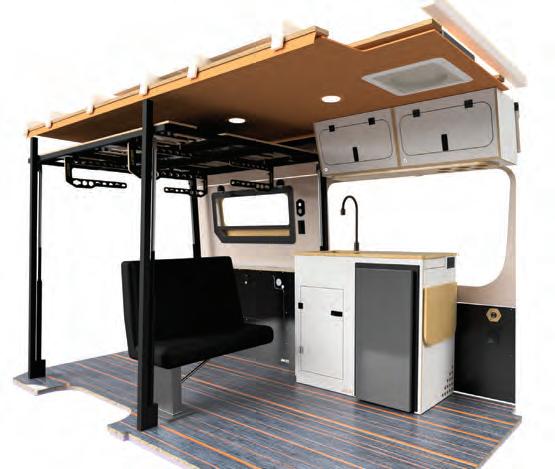




Cyndee






Cyndee



Cyndee

— Jacquie B.




